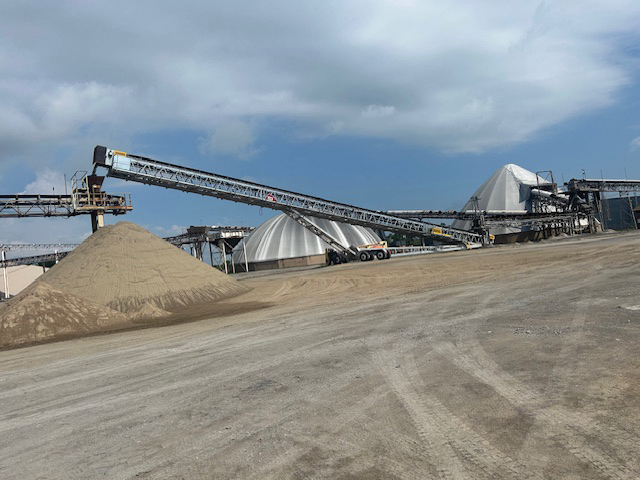The Paducah-McCracken County Riverport Authority is nearing completion of close to $6.6 million in grant projects awarded over the past five years.
The two state and two federal grants have allowed the port to reinvest in its infrastructure. That has included replacing some equipment that was 50 years old, Executive Director Jimmie Garrett said.
The port stretches from Mile 1.3 to 2.0 on the Tennessee River—near where the mouth of the Tennessee converges with the Ohio River. Its business involves unloading barges for customers and storing the cargoes, which are eventually distributed by truck. The port has no rail access, but expansion to a second site that would include rail access is under development.
PIDP Grant
The biggest of the grants, a 2021 federal Port Infrastructure Development Program grant through the Maritime Administration (MarAd), included seven projects to revitalize and expand the port’s bulk yard, Garrett told the Paducah City Commission at an August 26 meeting. Six of those projects are complete, with one currently underway.
The $3.82 million PIDP grant included the refurbishment of two storage domes that lost their roofs in a storm along with the purchase of three radial stackers, three ground conveyors, one other stacker, four generators and the installation of a truck scale, a concrete pad and a truck canopy, along with professional and engineering services. All the projects are designed to modernize the bulk yard, increasing its handling capacity and improving safety while also lowering its environmental impact.
The total project cost was $4.082 million, which was just over $264,000, or 6.9 percent, over budget, Garrett said. At the meeting, city commissioners unanimously voted to pay an additional $150,000, the same amount as the McCracken County Fiscal Court paid at a July 28 meeting. Garrett noted the riverport had already put more than $275,000 of its available funds toward the grant project, and existing customers had contributed $140,000 toward the required 13 percent local match for the grant.
The additional city and county contributions mean that both entities ultimately contributed $250,000 each for the PIDP grant.
Mayor George Bray commented about the importance of the riverport to the city immediately before the vote.
“It’s a recognized economic driver for our community,” he said.
Garrett said that the bulk of the increased cost over the original budget was due to one project, a truck canopy required to protect fertilizer from getting wet while being loaded in inclement weather. That project should be completed by the end of September.
Garrett noted that Southern FS is a large customer for the port, with about 50,000 tons of fertilizer arriving by barge each year and distributed by truck. The port’s largest shipments received annually by tonnage also include sand and limestone aggregate for construction, minerals used in making refractory bricks for steel furnaces and carbon and graphite for steel production and other manufacturing. An economic study found that construction materials unloaded at the port support about 600 jobs in the Paducah-McCracken County area.
Major port customers include Pine Bluff Sand and Gravel, TAM International, Southern FS, PRCO America, Superior Graphite, BD Seamless, Precision Machine, Midwest Products, Hiller Carbon, Hines Furlong Line, National Maintenance and Metal One.
Garrett said the three new radial stackers are especially important to port operations.
“When they took down the first radial stacker to replace it with a new one, it bent in half and collapsed to the ground, so the way I look at it is we got every useful day possible out of that radial stacker,” he said.
The radial stackers transport bulk products from a barge berth to both outdoor and enclosed storage areas within the riverport complex. The new stackers make up about a third of the port’s conveyor capacity, Garrett said. He expects to see the port’s maintenance costs decrease because of the new equipment.
Additionally, he said, refurbishing the storage domes has allowed the port to have added capacity.
“Generally, they have one to two barge loads of pet coke in them on a daily basis,” Garrett said.
The addition of the concrete storage pad, which is about the size of a football field, allows the safe storage of about 10,000 tons of material that can be stored outdoors but not mixed with soil or mud.
Other Grants
A $462,000 federal Delta Regional Authority grant allowed the renovation of a 19,600-square-foot warehouse built in 1977. That one warehouse contributes about $100,000 in revenue to the riverport annually.
Work on the building started last year and was completed in December, although a concrete travel way between the federal Free-Trade Zone cargo pad and the warehouse will be complete in 30 to 60 days.
PRCO became the first customer to use the Foreign-Trade Zone (FTZ) in July, despite the port having that designation for close to a decade. The federal designation allows companies to import goods without paying tariffs or duties, only paying them a little at a time as products are moved off site for manufacturing or sale.
So far, Garrett said, PRCO has shipped more than 5,500 supersacks and unloaded them in FTZ-designated warehouses at the port.
Separately, a $120,000 Kentucky Riverport Improvement Grant has allowed the purchase of a Broderson 15-ton mobile carry-deck crane and a U.S. Occupational and Safety Administration-approved man basket. The equipment should be coming in within a few weeks, Garrett said. The crane will allow port crews to maintain elevated conveyors and will help to safely transport employees on and off barges.
KRI grant funding also paid for a bulk hopper, $145,000; clamshell bucket, $47,250; access aprons, $54,250; a Bobcat skid-steer, $57,569; a trailer, $35,500; and a conveyor chute, $34,277.
Funding from another state grant, the Kentucky Public Riverport Construction and Maintenance (KPRCM) program, has provided $1,561,875 for three active projects at the Paducah riverport.
The first is the repair of eight of the port’s nine mooring cells. The project is scheduled to be out for bid later this month with repairs to be complete by spring 2026.
The port has also ordered a new Sennebogen 3.5-cubic-yard bucket.
Finally, the port is using grant funding to replace 200-foot and 160-foot fertilizer conveyors, each of which is about 50 years old.
Future Construction
While grant funding has allowed for continued operations, maintenance and expansion of the bulk yard at the riverport, a $3.5 million allocation from the state of Kentucky’s Budget Reserve Trust Fund in 2024 has led to planning of the new Riverport West project at Ohio River Mile 944. The site is nine river miles west of the existing port.
The allocation, part of House Bill 1, paid for environmental studies and design to the 90 percent level for the project. It will include a heavy haul road and a dock with three barge berths and a general cargo laydown area adjacent to existing rail lines on what the Greater Paducah Economic Development Corporation (GPEDC) is marketing as the Ohio River Triple Rail Site.
Through its industrial development authority, GPEDC owns or has optioned about 800 acres of property, expandable to 1,000 acres, in west McCracken County.
“Riverport West will provide all three forms of transportation: river, road and truck,” Garrett said.
Already, he said, energy and industrial customers have shown interest in the site.
Developers last summer opted to raise the access road 3.5 feet in elevation, beyond the 500-year floodplain, so that the river level would not be likely to impact the ability of any customers to use the dock.
Developers have paid just over $1.2 million in expenses from the allocation so far, Garrett said. Work on the design is in its final 60 days. Meanwhile, field work is being completed for wetland and physical surveys and soil testing. Next steps would be development of the overall project construction costs and evaluating potential funding options, which could include partnerships with industry as well as the potential for state or federal funds.
Garrett said regional economic development and government leaders, along with the port authority, are meeting with Paducah-based engineering firm Bacon Farmer Workman every couple of weeks for updates.
Looking toward future needs, Garrett told the city commission the port has identified several potential projects and plans to seek grant funding for them over the next two fiscal years. They include replacement of Warehouse No. 1, a new roof for Warehouse No. 4, scale house replacement, a bulk yard access road and a new, 30,000-square-foot warehouse.
————
Featured photo caption: New radial stackers and refurbished storage domes are among the improvements to the bulk yard at the Paducah-McCracken County Riverport Authority, which is wrapping up completion of its 2021 Port Infrastructure Development Grant. The port has completed roughly $6.6 million in grant projects awarded over the past five years. (Photo courtesy of the Paducah-McCracken County Riverport Authority)




